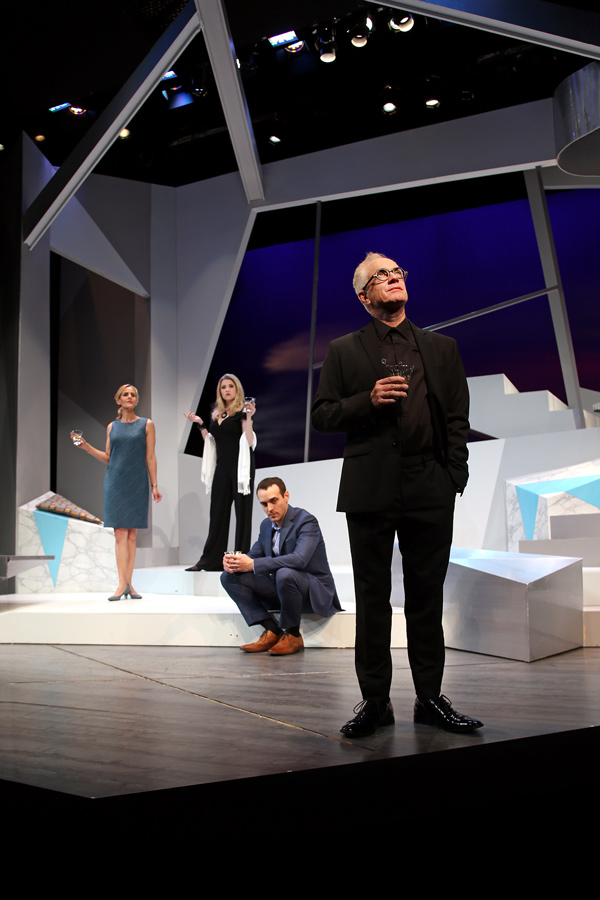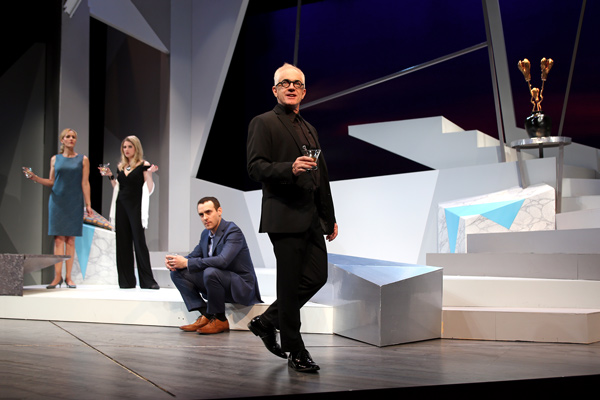From the moment the stage lights go up for The Monster Builder, the audience is caught in a whirlwind of over-the-top sophisticated banter, much of it addressing architecture. The first scene reveals an ultra modern glass house with inhabitants, Gregor, the starchitect, played with egomaniacal self-importance by Danny Schiele, and Annie Abrams performing as Tamsin, his sexy, bubbleheaded actress girlfriend. In fact much of the acting is in sync with the overblown tone of the play, as the six players, three men and three women, speak in the “thrilling” overacted manner, characterized by 1930s and ’40s movies. And director Art Manke creates characters who appear overly self-conscious about their presence in an, at first, seemingly perfect world.

Susannah Schulman Rogers, Annie Abrams, Aubrey Deeker and Danny Scheie in South Coast Repertory’s 2017 production of The Monster Builder by Amy Freed. Photo by Debora Robinson/SCR.
Gregor Zubrowski, as this dark comedy reveals, is not only the world’s most famous architect, he creates buildings so extravagant, they would render Frank Gehry’s designs as mundane. Aware of his status, Gregor roams the stage, making statements as, “I rarely do residences. Least of all, my own. I’ve always preferred to build less vernacular structures.”
Gregor’s and Tamsin’s guests, Rita (played by Susannah Schulman Rogers) and Dieter (Aubrey Deeker), a youngish couple who are budding architects, are so enthralled by the elder architect’s accomplishments, they knock themselves out complimenting him. Rita says about his house, “one hardly knows how to describe it –clearly though, Your Masterwork! Congratulations! Gregor, you’re a genius.”

Susannah Schulman Rogers and Aubrey Deeker in South Coast Repertory’s 2017 production of The Monster Builder by Amy Freed. Photo by Debora Robinson/SCR.
But Rita and Dieter have an ace in the hole, a job renovating a classic old boathouse. Gregor is intrigued and in a subsequent scene, he makes a call and gets himself hired to fix the boathouse. The action becomes even more dramatic, with Gregor offering Rita a job working for him on the boathouse, and with Dieter chagrined at this turn of events.

Susannah Schulman Rogers and Danny Scheie in South Coast Repertory’s 2017 production of The Monster Builder by Amy Freed. Photo by Debora Robinson/SCR.
Soon, an ultra-rich name-dropping woman, Pam (performed with exaggerated voice and body language by Colette Kilroy) and her working class husband, Andy (the most down-to-earth character in the play) visit Rita and Dieter’s humble office as clients; Pam soon proposes outrageous decorative changes to her home, such as floating a Samoan canoe over a table.

Susannah Schulman Rogers, Colette Kilroy and Gareth Williams in South Coast Repertory’s 2017 production of The Monster Builder by Amy Freed. Photo by Debora Robinson/SCR.
As the play progresses, Gregor enters his Gothic office, revealing his deeper maniacal nature, as he plays with great flourish Bach’s “Toccata and Fugue in D minor” on his pipe organ. He then proceeds to seduce Rita, who has reluctantly agreed to work with him on the boathouse. But Dieter, the most levelheaded of this zany group, has researched Gregor’s demonic and supernatural background, eventually disclosing his findings to Rita and Tamsin, who is by now plotting her revenge on him (in a previous scene, he tried to drown her).
Subsequent scenes build to a crescendo, but the play finally descends to a human scale, indicating that monsters such as Gregor will ultimately not prevail. The Monster Builder was written a few years before the 2016 Presidential election. Yet its message is in tune with much of today’s political climate, making this delightfully dramatic play a kind of comeuppance for today’s news addicts.
The Monster Builder by Amy Freed, directed by Art Manke at SEGERSTROM STAGE, at South Coast Repertory, through June 4, 2017
—


